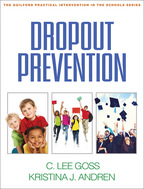Dropout Prevention
C. Lee Goss and Kristina J. Hokkanen
This title is part of The Guilford Practical Intervention in the Schools Series, edited by Sandra M. Chafouleas.
“This carefully researched book provides insights and, more important, clear direction for those committed to dropout prevention and intervention. With an emphasis on multi-tiered systems of support such as response to intervention, the authors provide an action plan to stop student disengagement from learning, which can start as early as elementary school. The book identifies critical measurable indicators of dropout risk and offers evidence-based practices to reduce risk at both the elementary and secondary levels. I highly recommend this book for educators looking for ways to reach their most challenging students and create positive learning outcomes.”
—Kathleen L. Vespia, EdD, Secondary Education Coordinator, Salve Regina University
“One of the few resources on dropout prevention that thoroughly examines how to organize evidence-based practices within a multi-tiered system of support. This is a superb resource that integrates depth of scholarship with practical application. The book focuses on implementing academic interventions and social/behavioral supports to create effective school environments that increase student engagement. The authors have made a major contribution to addressing a complex and persistent challenge.”
—A. James Artesani, EdD, College of Education and Human Development, University of Maine
“Provides a well-researched and holistic approach. The authors clearly understand both the complexity of this issue and how to apply strategies that have been proven to be successful. All preservice teachers would be fortunate to take a course that incorporates this text, and master's and doctoral students in education leadership would add much to their knowledge and expertise. This is also a much-needed professional development resource for those already working in schools. It addresses the full range of dropout prevention needs at all levels and what can be done about them.”
—Marty Duckenfield, former Public Information Director, National Dropout Prevention Center, Clemson University
Table of Contents
I. Systemwide Dropout Prevention1. The Dropout Crisis
2. School, Family, and Community Partnerships
3. Academic and Behavior Links to Inform Dropout Prevention Methods
II. Dropout Prevention at the Elementary Level
4. A Process, Not an Event: Early Identification of Dropout Risk
5. Tier 2 and Tier 3 Problem Solving at the Elementary Level: Are We Closing the Gap?
6. Early Intervention: Elementary Evidence-Based Resources (with Jennifer L. Robert)
III. Dropout Prevention in Middle School and High School
7. Time Is of the Essence: Early Warning Systems for Middle School and High School
8. Tier 2 and Tier 3 Problem Solving at the Secondary Level
9. Middle School and High School Evidence-Based Resources (with Jennifer L. Robert)
10. The Role of Technical Education, Alternative High Schools, and Postsecondary Options in Dropout Prevention
Conclusion: Time for a Change
Appendix: Reproducible Materials
Appendix A. Checklist for Monitoring and Improving Family Engagement
Appendix B. Academic Intervention Record Form
Appendix C. Building an Early Warning System
Appendix D. Evidence-Based Interventions
Appendix E. Online Resources for Dropout Prevention and Intervention Methods
About the Authors
C. Lee Goss, PsyD, NCSP, is a Lecturer in the Educational and School Psychology Programs at the University of Southern Maine. She has provided school psychology services, professional development, and consultation for schools and districts in multi-tiered, system-wide prevention and early intervention methods. In private practice, Dr. Goss takes a collaborative and comprehensive multidisciplinary approach to supporting children and adolescents at risk for academic, social, and mental health problems that often result in underachievement and school failure. Her research interests include prevention, early intervention, and problem-solving methods to inform effective interventions and dropout prevention.Kristina J. Hokkanen, PsyD, NCSP, has practiced as a school psychologist in Maine schools since 2005. She served as Assistant Professor of Educational and School Psychology at the University of Southern Maine, and continues to be affiliated with the University as a supervising licensed psychologist for PsyD school psychology interns and practicum students and as a member of the School Psychology Advisory Board. Dr. Andren's research interests include assessment and intervention within a multi-tiered systems of support (MTSS) framework. Her current work focuses on the application of MTSS methods—such as response to intervention—to reading initiatives, schoolwide practices, and dropout prevention.
